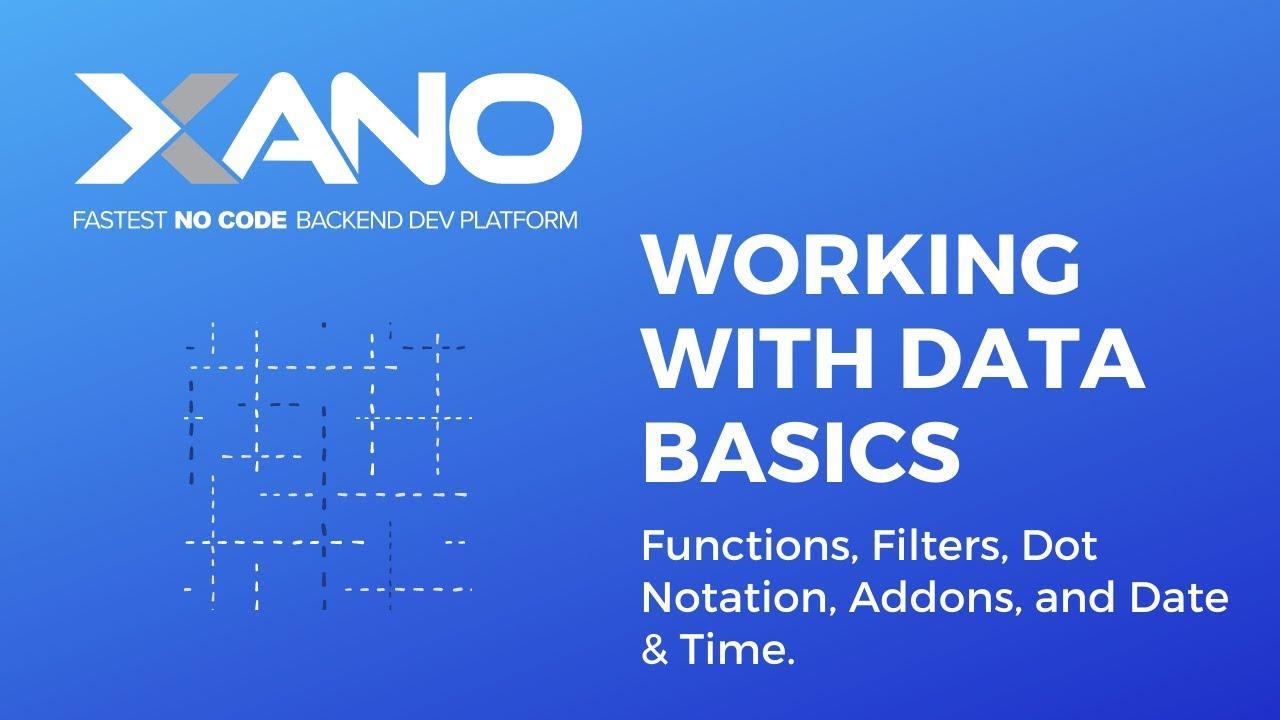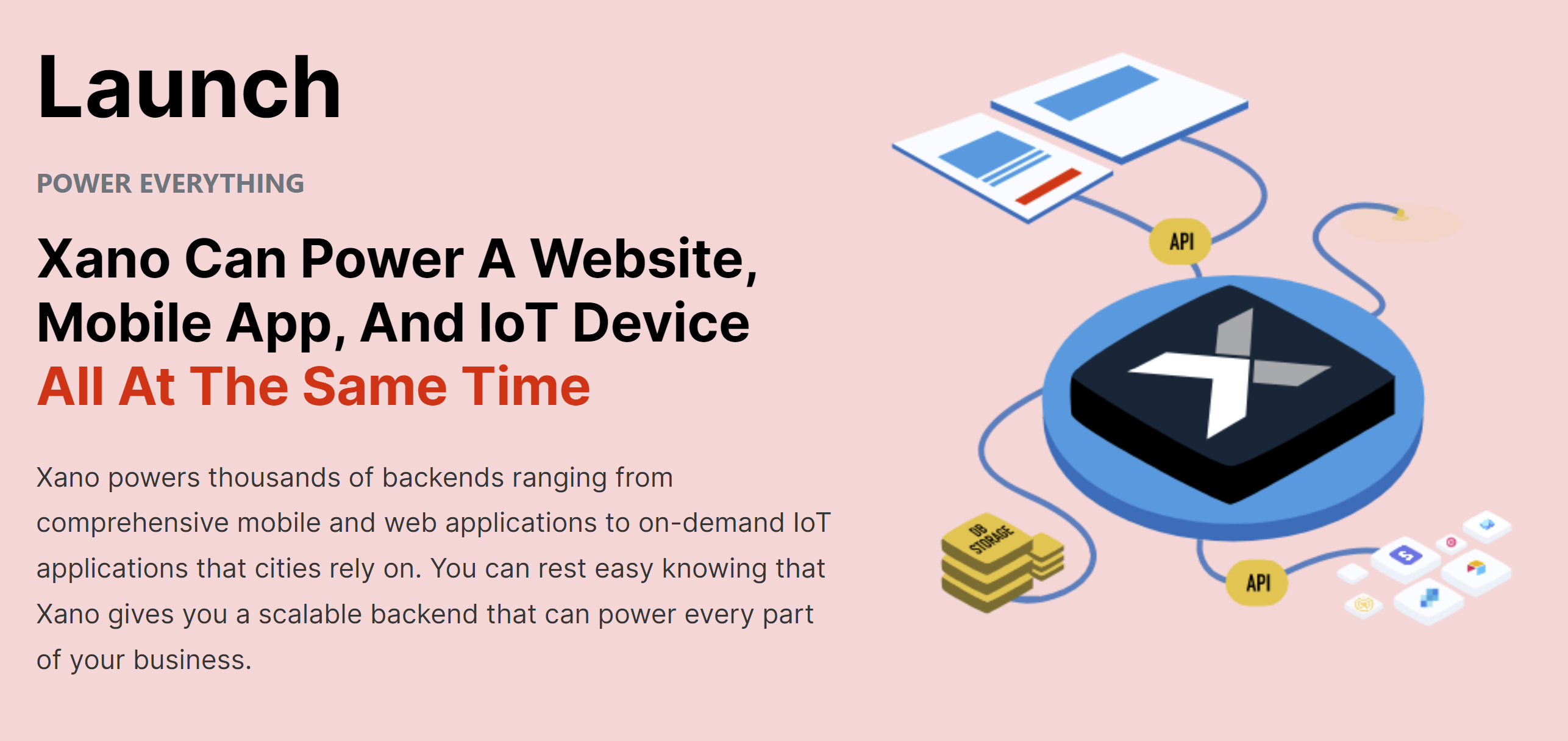Xano
First, some information about the No Code backend: how does it work? What is it?
Before explaining everything about Xano , its features and its cost of use, we will first deepen our understanding of No-code backend development .
The market has already seen a revolutionary movement with " Low-code " development. While low-code development requires little or no coding to create applications or processes, No-code, as the name suggests, is a programming platform that allows you to create APIs without any coding.
The question you're asking is: how can you create an API without writing a single line of code ?
This is done by allowing any creator to simply drag and drop pre-configured blocks to create advanced, professional-quality applications and break down the barriers between ideas and solutions. It also allows you to instantly edit, delete, or update any changes made to the application through a visual interface and therefore without any dependency on code solutions.
No-code development has not only simplified and made it a scalable backend development process, but also made it faster and more affordable than traditional development tools.
How does it work?

Well, truth be told, no-code does involve some coding, but it's done completely behind the scenes, almost invisible to the builder thanks to the no-code tool. So, a no-code tool uses a visual development interface and is based on "declarative programming." In declarative programming, the focus is on the "what" part of development, not the "how." This means you control the system according to what you want and it builds for you.
This is quite unlike traditional software application platforms or even low-code development methods. As with both platforms, you must research, write, test, and script some or all of the code that contains instructions to the platform on how to implement a given feature or functionality.
Simply put, low-code platforms allow technically skilled people to run applications, while a no-code platform allows you to operate them without any traditional development skills.
We hope you have a better understanding of a no-code API generator and how it works. Now let's move on to discussing what Xano is. How is Xano the fastest no-code backend development platform?
XANO: origin, functionality, cost and features
According to Xano's website , it provides users with "a scalable server, a flexible database, and a no-code API builder capable of transforming, filtering, and integrating data from anywhere."
The website also explains how the platform was initially designed as an internal tool for an app development agency eight years ago. Xano was created to help the agency accelerate its backend development without having a brigade of DevOps teams. Later, the co-founders finally decided to launch the platform publicly. Since then, Xano has become one of the most versatile, reliable, and easily accessible no-code development platforms.
Xano isn't just your typical no-code development platform, as it offers a wide range of features, from a scalable server to API deployment, project management, and even database management. It can also power the backend of other types of development projects, such as IoT. It's a multitasking device.
Xano Price:
Xano is free but also offers a premium subscription-based plan. It has divided pricing into three categories: Free, Launch, and Scale. Here's what the pricing for each of its plans looks like in the US:
- Build: It's free. Limited to 1 workspace with a total of 10,000 records, No-code API generator , an extension marketplace, and limited API pricing .
- Launch : Costs $59 per month, includes 3 workspaces with 10GB of media storage, 5 background tasks, no recording limits, and no API rate limitations .
- Scale : Costs $199 per month, includes 5 workspaces, 15 background tasks, 50GB of media storage with no recording limit, but includes 10GB of base storage and load balancing.

The main features of Xano are:

- You can tailor it according to your business requirements and needs, hassle-free.
- Provides a hosted and flexible database based on Postgres.
- Supports REST API paradigm and helps you transfer data to any frontend tool (with code, No-code or with low-code).
- Xano's No-Code API Generator allows you to customize REST API endpoints for each data table based on a specific schema.
- Xano is easy to use and doesn't require much configuration once you're logged in.
- It supports authenticated API requests and allows you to create custom functions to query databases without coding.
- All types of data are secure with Xano. It offers full data ownership and confidentiality to its users only and meets GDPR compliance.
5 Steps to Set Up a Xano Account: A Brief Guide
Getting started with XANO is as simple as creating an app with this software. When you create an account with it, you'll be redirected to Jumpstart. This site asks you to provide key information about your project. Once you've entered and answered the key data points, XANO will automatically create a secure backend for you. Yes, it's that simple. So, follow these simple steps to start building apps with XANO:
1. Create a Xano account and mention your instance. This will allow users to proceed to the next step and create a workspace for them. Your workspace is a container for users' applications or projects.
2. Once you have created a workspace (try to give it a good name), the Jumpstart will ask you a few questions to personalize your experience using XANO.
3. After naming the workspace and answering the questions, decide how you want to work in XANO. You will be asked to choose from the three options below:
- Start from scratch — You will define the database tables based on the application you plan to build. XANO will manage the CRUD (Create Read Update Delete) API endpoints for you.
- Import from Airtable: Sync your databases, relationships, and content.
- Start with a template: XANO will create pre-built, scalable backend templates that include database tables, API endpoints, and mock content.
4. The next step is to decide whether to authenticate your application by registering or logging in.
5. The last step is to press “Finish” when you are done adding authentication to your app, and voila, you can turn your business app idea into reality with Xano.
How to Develop Apps with a No-Code App Builder: The Xano Method
Nearly a decade ago, the idea of developing an API generator without coding might have seemed completely impossible. But with the emergence of no-code development and even low-code development tools and platforms, it's no longer a far-fetched idea but a reality. Today, many businesses are thriving.
Thanks to the lack of coding platforms like Xano, creating an app is no longer a matter of complex coding lines, and maintaining it is not a costly or time-consuming affair either. No developer can be a person with or without programming skills and still be able to create and manage an app, without having to code.
Building apps in Xano or other no-code tools or platforms may not require any coding, but it involves three essential components and is quite fundamental to understanding the importance of no-code app builders and how Xano itself works. These components are the frontend, the backend, and the API.
Let's make this easier to understand. Imagine you're a food delivery company, you've partnered with many food chains and restaurants that prepare the food and deliver it to passengers, who then deliver it to the customer who ordered through the app. Now, your customer is your contact, who places the order or makes the "requests." Your restaurant is the backend that processes the order, and your client is the API, which mediates between the frontend and the backend.
What role do no-code app developers play? How do they enable these components? They replace the work of the rider and restaurant. They provide you with robust, secure backend and frontend technologies that manage complex code for you and respond to real-world requests.
So how does Xano make this possible?
We've already explained how traditional development technologies are not only time-consuming and expensive, but also quite difficult to change, update, or modify without delay. You need to ensure that the change is integrated into the entire project: the frontend, the API, and the backend before requesting any type of change. These changes can take a week or even months to complete if your software development team is busy with other tasks, resulting in a loss of user base and profit margins.
As a no-code platform, Xano saves you from having to go through such a lengthy process to make changes to your application. Using a user-friendly, point-and-click dashboard and a built-in library, you can simply "tune your queries and model database relationships without coding." Xano also automates the backend coding process for you, so you don't have to add any extra hassle to your development team.
What can you create with Xano?

As we saw above, Xano is multitasking. Not only does it help citizen developers (people with little or no technical expertise) develop an app from scratch without coding, but it does much more. Similarly, with Xano, you can not only create apps without writing a single line of code, but you can also achieve much more. These include:
- Web applications
- Mobile apps
- Web portals
- Workflow Management
- Enterprise Applications
- Customer Relationship Management (CRM)
- Supply
- Help Desk Management
- Project and task management
- Human Resource Management System (HRMS) Self-Service for Employees
- Travel and expense management
- Asset management
...and you can do much more with Xano!
Conclusion
There's no doubt that no-code application development has revolutionized the IT world. It has significantly simplified application development with a drag-and-drop interface for feature-rich enterprise APIs. Xano has played a key role in helping citizen developers—"non-technical people"—implement solutions that embody productivity, are highly performant, and save time and costs. All this and more, without having to dig a hole in your budget, gives small businesses or startups breathing room to build, manage, and maintain their applications.
We hope this blog helps you gain a basic understanding of the No-code development platform, how it works, what Xano is, and its features and functionalities. Drop us a comment if you still have any doubts or questions about Xano or No-code development.



